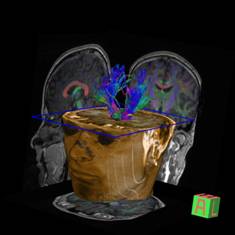New Edinburgh diagnostic imaging centre improves early detection of disease
01 Dec 2010
The Clinical Research Imaging Centre (CRIC) is a fully integrated medical imaging facility to improve diagnosis and treatment of illnesses such as cancer, heart disease and multiple sclerosis.
Recently opened by HRH Prince Philip, Duke of Edinburgh, it is a collaboration between the University of Edinburgh and NHS Lothian. It features a Magnetom Verio 3Tesla MRI and a Biograph mCT PET-CT system from Siemens Healthcare.
The facility will allow earlier detection and a deeper understanding of conditions without invasive procedures such as biopsies or angiograms. The Magnetom Verio 3T MRI provides highly detailed diagnostic imaging allowing researchers to conduct neurology, oncology and musculoskeletal scans with ease. Its large 70cm bore enables greater flexibility and can accommodate a wider range of patients to allow clinicians to capture sharper images due to less anxiety-related movement.

Image of a patient’s brain stem using MR diffusion tractography
techniques from the Magnetom Verio 3T MRI from Siemens Healthcare.
The Biograph mCT PET-CT system combines CT technology with High Definition PET to provide a greater depth of information during one, noninvasive examination. It adapts to virtually any patient and any clinical need with higher resolution, contrast and speed. The ability to visualise the metabolic functions of the body and the patient’s anatomy at the same time also means diseased tissue can be more accurately located, ensuring the patient is given the most appropriate course of treatment. Novel tracers will also be used to investigate tissue inflammation to help identify heart and lung diseases as well as helping to identify neurological changes such as multiple sclerosis and Parkinson’s disease.
Professor Edwin Van Beek, Director of the Clinical Research Imaging Centre, said, “There have been dramatic advances in imaging over the past decade, changing the way we look at disease and our understanding of the biological processes involved. Now rather than simply looking at the structures of the body — such as the heart and the brain — we can look at how organs are functioning in real time. This will not only help us better understand disease but it will assist us improve both diagnosis and treatments.”
Professor David Newby, Head of Research and Development for NHS Lothian, who also holds the British Heart Foundation John Wheatley Chair of Cardiology, said, “This world-leading new centre brings together the very latest imaging technologies in a single facility. With the University of Edinburgh’s world-leading clinical research, this will allow a major improvement in our ability rapidly to investigate and understand the most serious and distressing diseases in our patients.”
“The relationship between the Clinical Research Imaging Centre and Siemens Healthcare is developing into a long-standing partnership. The installation of the Magnetom Verio 3T MRI and a Biograph mCT PET-CT system will help CRIC to drive clinical research and advancements,” said Dr. Craig Buckley, UK Scientific Support for Magnetic Resonance Systems at Siemens Healthcare. “This is a fantastic collaboration for both of us to advance imaging innovation and move forward the prevention, detection and understanding of clinical conditions and disease.”
The Clinical Research Imaging Centre has been created by the University of Edinburgh and NHS Lothian, with funding from the British Heart Foundation, Medical Research Council, Wellcome Trust, and other charities and private supporters.